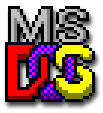MS-DOS
November 27, 2007 Despite Tandy’s DeskMate application which tried to handle a number of disk and application related functions, MS-DOS (Microsoft Disk Operating System) was the actual operating system on which Deskmate needed to operate. I had experience with an earlier version of Microsoft’s DOS which I used at school; I believe the versions were 2.0 and 1.25. Unlike today where hard drives are common place and often taken for granted, the machines in the lab could only boot by way of 5 1/4″ floppy diskettes which contained the operating system. I believe the Tandy computer came with MS-DOS 3.42 and it was pre-installed on the hard drive. This was so much better than booting from a floppy, and I quickly assimilated as many commands as I could, since the school never gave me the time I wanted on the machine or the resources. Even with the aid of a text book, there were a few commands which took me a while to grasp, like COMMAND.COM or DEBUG.COM. My understanding of these wouldn’t completely solidify until I started programming in lower level languages like C and assembly language. I was also introduced to Microsoft’s shell scripts which they called Batch files. With the addition of extra software on the system, these scripts could actually become fairly sophisticated. Before I moved on to greener pastures and more flexible user interfaces, my system had sophisticated menus and launchers which helped my family out when they wanted to use the machine (it wasn’t often, but it did happen).
Despite Tandy’s DeskMate application which tried to handle a number of disk and application related functions, MS-DOS (Microsoft Disk Operating System) was the actual operating system on which Deskmate needed to operate. I had experience with an earlier version of Microsoft’s DOS which I used at school; I believe the versions were 2.0 and 1.25. Unlike today where hard drives are common place and often taken for granted, the machines in the lab could only boot by way of 5 1/4″ floppy diskettes which contained the operating system. I believe the Tandy computer came with MS-DOS 3.42 and it was pre-installed on the hard drive. This was so much better than booting from a floppy, and I quickly assimilated as many commands as I could, since the school never gave me the time I wanted on the machine or the resources. Even with the aid of a text book, there were a few commands which took me a while to grasp, like COMMAND.COM or DEBUG.COM. My understanding of these wouldn’t completely solidify until I started programming in lower level languages like C and assembly language. I was also introduced to Microsoft’s shell scripts which they called Batch files. With the addition of extra software on the system, these scripts could actually become fairly sophisticated. Before I moved on to greener pastures and more flexible user interfaces, my system had sophisticated menus and launchers which helped my family out when they wanted to use the machine (it wasn’t often, but it did happen).
Version 5 was a much more refined operating system and contained powerful commands and programs like QBasic. It also featured a memory manager which allowed software to access all of that wonderful new memory that you may have been fortunate enough to acquire. Although it was included in MS-DOS Version 4, I believe the DOSSHELL command’s popularity spiked in Version 5. This was a program which was intended as a graphical replacement to the dull COMMAND.COM shell. It introduced a feature called task swapping which allowed you to load more than one program but only run one of them at a time; unlike multitasking which appears to run more than one program at the same time. Also, DOSSHELL could not load more programs than your memory would allow since it did not have a paging mechanism. Naturally, all of these benefits conflicted with the new versions of Windows which did exactly the same thing only better, and was soon relegated to a supplemental disk in future releases before being dropped entirely.
Version 6 introduced the much feared DELTREE command. DELTREE was a command which could recursively remove directories and files; it was so feared because new or untrained users would presumably delete their entire operating system accidently. If this was indeed a problem, I think they should have modified the program to make it more difficult to accidently trash your operating system by adding extra prompts and warnings for example, since it is a very useful command in some circumstances. Despite its notoriety, it was a fairly simple command as far as software goes, and the void was soon filled by programmers who released new versions on the Internet which did exactly the same thing only better; I wrote a utility to replace it as well but mine displayed a user interface if you specified the right command option.
Categories: DOS, Reflections, Software
No Comments »







No Responses to “MS-DOS”
Care to comment?